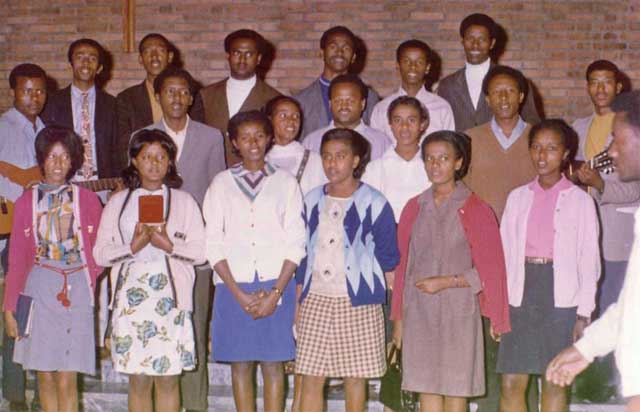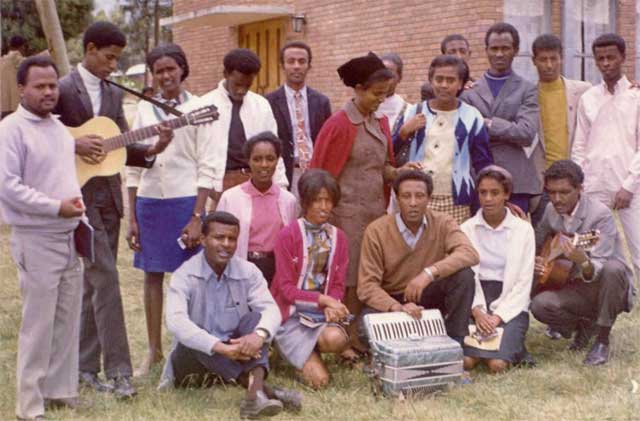Mulu Wongel Church “A” Choir emerged in 1969 out of a group of few passionate members of the Ethiopian Full Gospel Believers’ Church (EFGBC; Amh.: Mulu Wongel) in Addis Ababa who used to sing individually and in few groups. It was the Church’s first choir. While there were several contributing factors for the inception of the choir, the Araya Family choir had a unique place in motivating and influencing the establishment of this choir.
The founding members of the choir were about ten in number, among them Getachew Mikre, Tsegaye Kabtimer, Zerfnesh Woldetsadik, Menbere Hezekias, Mekdes Belete, Kelem Belete and Yalew Kebede. Getachew Mikre was the leader and used to coordinate the overall functions of the choir. He also used to accompany the singing of the choir on the accordion, whereas Bayiru Seyoum played the guitar. The key songwriters were Legesse Wetro (Prof), Addisu Worku, Yigezu Desta, Ejgayehu Beyene, Tesfaye Woldeyesus, Bitsiat Tirfe, Atalay Alem (Prof) and Almaz Haile.
In 1970, the choir commenced its service in public at Addis Ababa Mekane Yesus Church and Addis Ababa Adventist Church. In addition to worship services in church congregations, the choir also sang in schools, hospitals (e.g., Zewditu Hospital), at wedding ceremonies, funerals and in the stadium. The Jimma Philadelphia church invited the choir in 1971 to serve at a spiritual conference, and that marked the choir’s first ministry out of Addis.
In 1971, during the period of Emperor Haile Selassie, the Mulu Wongel Church’s physical operation was closed for the first time. The choir was nevertheless invited to serve in many churches, even in such distant cities as Harar and Dire Dawa in the east and Arba Minch in the south. The seizure of power by the DERG military regime in 1974 led to severe persecutions in many parts of the country. The atheist government officially closed the Ethiopian Full Gospel Believers’ Church. Some members of the choir were imprisoned, but the choir as such was not persecuted. Doors opened for the choir to serve in many other denominations.
During the Ethiopian Revolution, any gathering with more than five people was strictly prohibited. Hence, the choir was forced to meet, pray and practice songs in smaller groups in private houses. The members of the choir took a risk to get together and resume services through the churches’ underground schemes, yet they were covered and protected by the blood of the Lord Jesus Christ whenever holding meetings in those difficult times.
Mulu Wongel “A” Choir brought about a paradigm shift in presenting original gospel songs with the Ethiopian national music styles and flavours (“Habesha zema”) during the early stages of its ministry. Previously, most hymns presented by evangelical church choirs in Ethiopia used to be translations of foreign works.
The choir’s music style included unison, half solo, duet, quartet and four parts, in Amharic and sometimes in English. Several observers believe that the messages of its gospel songs attracted more souls to Christ than the preaching and teaching delivered on Sunday services. Songs like “Kemotim yadinal Eyesus (1970), Amlak eregnaye new (1970), Misgana Leyesus misgana (1974), Besheleko bitalf (1971), And ken yimetal (1971) Amelkalehu yihinin talak Geta (1973) and Linarf new wondim (1973) influenced many believers to live out practical Christian disciplines, glorify God, live an exemplary life, give testimony to others about the saving power of the Lord Jesus Christ and exhort believers to lead a solemn life in anticipation of the second coming of the blessed Bridegroom.
Mulu Wongel “A” Choir also set an example by serving in denominations other than its mother church. Thus the choir played a pivotal role in the movement and manifestation of the Holy Spirit’s work in Ethiopia. The more opportunities the choir got to sing, the more the Holy Spirit used it to rekindle believers in many churches. As a result, revivals occurred, and the work of the Holy Spirit was accepted in almost all denominations. Since then, the awakening of believers by the power of the Holy Spirit has been experienced throughout the country.
Numerous songs of the choir had a high broadcast share in the Christian radio service called Yemisrach Dimts. The program was prepared and presented by Dr Nigussie Tefera. He underscores that the songs of the choir were not only the hallmarks and emblems of a severely persecuted church, but to many they were also sources of edification, admonition and spiritual awakening (Nigussie Tefera, Introduction to the choir’s DVD Kemotim yadinal, 2018 [cf. Discography below]).
Albums
(1) Kämotəm yadənal [ከሞትም ያድናል, Jesus saves even from death]. Cassette produced [Q: recorded by YDCS?] and distributed by Mulu Wongel Believers’ Church, Addis Ababa 1971.
(2) Məsgana [ምስጋና, Praises]. Cassette produced [Q: recorded by YDCS?] and distributed by Mulu Wongel Believers’ Church, Addis Ababa 1973.
(3) Yä’ǝgziʼabǝher bäg [የእግዚአብሔር በግ, Lamb of God]. Cassette produced [recorded by YDCS?] and distributed by Mulu Wongel Believers’ Church, Addis Ababa 1979.
(4) Ǝgziʼabǝherǝn amäsgǝnu [እግዚአብሔርን አመስግኑ, Praise God]. Cassette produced [recorded by YDCS?] and distributed by Mulu Wongel Believers’ Church, Addis Ababa 1979.
(5) Wädoñal [ወዶኛል (?), He has loved me]. Cassette produced and distributed by Mulu Wongel Believers’ Church, Addis Ababa 1992. [Q: ወድዶኛል, He has loved me?]
(6) Yägälilaw Iyäsus tänäs [የገሊላው ኢየሱስ ተነስ, Jesus of Galilee arose]. Cassette produced and distributed by Mulu Wongel Believers’ Church, Addis Ababa 1993.
(7) Ǝwunätəm Geta näh [እውነትም ጌታ ነህ, Indeed, You are Lord]. Cassette produced and distributed by Mulu Wongel Believers’ Church, Addis Ababa 1998.
(8) Amäsägənähalähu [አመሰግንሃለሁ, I paise You]. Cassette produced and distributed by Mulu Wongel Believers’ Church, Addis Ababa 2010.
(9) Kämotəm yadənal [ከሞትም ያድናል, He (Jesus) saves even from death]. CD and DVD, music mixed by Natty Digital Studio and pictures produced by Close up Pictures, released and distributed by Mulu Wongel Believers’ Church, Addis Ababa 2018.
Q: Picture of albums?
Songs in hymn books
God is Here (1981)
Wädase Amlak, vol. 4 (1997/98)
- p. 25/26, 109/10
Connect
» Visit Mulu Wongel Believers Fellowship Network’s YouTube channel
Audio
» Listen to albums
» Listen to songs
Video
» Watch worship songs
» Watch interview and documentary videos
Pictures




Further reading
Haustein, Jörg. Writing Religious History: The Historiography of Ethiopian Pentecostalism. Wiesbaden: Harrassowitz, 2011.
Solomon Kebede. _ _ _ [Before It Was Known by This Name. The 25th Anniversary of the Ethiopian Full Gospel Believer’s Church: From 1959 to 1984 A.M.]. Ed. Ethiopian Full Gospel Believer’s Church, 16. Addis Ababa, 1992 [A.D.]
Yosef Kidanewold. “The History of the Pentecostal Movement in Addis Ababa: 1963-1976.” BA thesis. Addis Ababa University, History Department, 1976.
Q: Seminary Paper, article in Christian magazine, etc. ?
Cross-reference
Vignette of Getachew Mikre